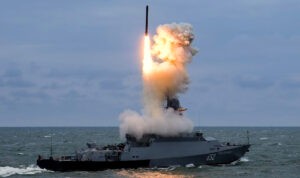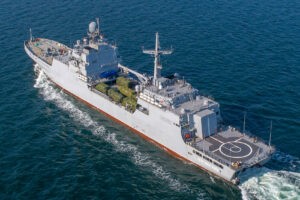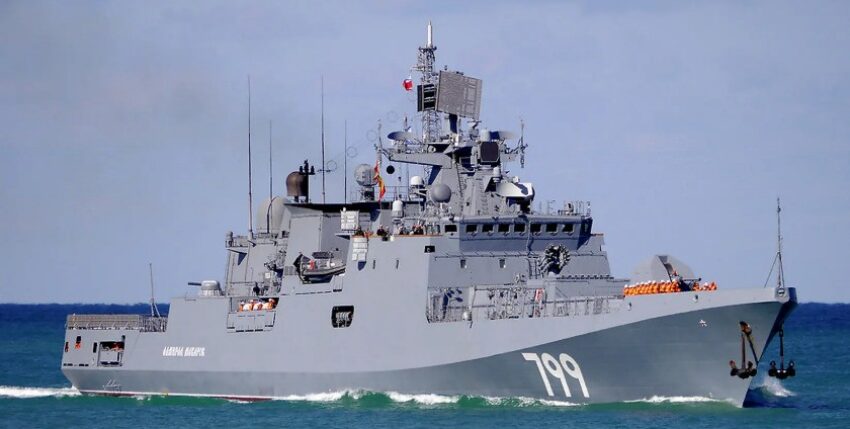[et_pb_section fb_built="1" _builder_version="4.16" global_colors_info="{}"][et_pb_row _builder_version="4.16" background_size="initial" background_position="top_left" background_repeat="repeat" global_colors_info="{}"][et_pb_column type="4_4" _builder_version="4.16" custom_padding="|||" global_colors_info="{}" custom_padding__hover="|||"][et_pb_text _builder_version="4.17.0" background_size="initial" background_position="top_left" background_repeat="repeat" hover_enabled="0" global_colors_info="{}" sticky_enabled="0"]
As if the question of the remaining threat potential and the whereabouts of the assembled Russian naval forces had arisen simultaneously here and there after the fire/sinking of the "Moskva", the Ukrainian news portal "Ukrainskaya Pravda" published the answer from Kiev's perspective at midday on Thursday, 14 April 2022. It is short and sweet: 56 launch silos for cruise missiles remain south of Ukraine!
The potential
This is still an unchanged overpowering potential for destruction, as the "Moskva" is known to have had no land target capabilities on board. It is also not known here how many Kalibr reloads of the emptied Black Sea launch silos are available in the Russian Federation, or how many have already been used for reloading from the reserve and combat stocks of the other fleets - but the supply of Kalibr cruise missiles cannot be endless either! Nevertheless, the list is quite revealing:
2 Grigorovich frigates "Admiral Essen" and "Admiral Makarov", 8 x SS-N-30 each;
3 Buyan-M small corvettes "Vyshny Volochyok", "Ingushetia" and "Grayvoron", 8 x SS-N-30 each;
4 kilo-submarines "Rostov-on-Don", "Stary Oskol", "Veliky Novgorod" and "Kolpino", 4 x SS-N-30 each via torpedo tube.
Makes a total of 56 missiles.
Small and large invoice
However, this seems to be a far too short calculation, because the enemy's potential should also include the units of the Black Sea Fleet "stuck" in the Mediterranean after Turkey's blockade of the Bosporus, as well as the missile corvettes of the Caspian Flotilla.
Caspian FlotillaThese units had already deployed their cruise missiles against Syria:
2 Gepard corvettes, "Tatarstan" and "Dagestan", 8 x SS-N-30 each;
3 Buyan-M small corvettes, "Grad Sviyazhsk", "Uglich", "Veliki Ustyug", 8 x SS-N-30 each.
Black Sea Fleetin the eastern Mediterranean on the edge of the FK range to Ukraine, probably based on the newly built harbour facilities in Tartus on the west coast of Syria - and left in place by the Russian side for the scenario there:
1 Grigorovich frigate "Admiral Grigorovich", 8 x SS-N-30;
1 Buyan-M small corvette "Orekhovo-Zuyevo", 8 x SS-N-30;
2 kilo-submarines "Novorossiysk" and "Krasnodar", 4 x SS-N-30 each via torpedo tube.
From the other fleets the news situation from Kiev also lists the following larger units:
2 Slava cruisers "Marshal Ustinov" and "Varyag", (North/Pacific Fleet);
2 Udaloy frigates "Vitseadmiral Kulakov" and "Admiral Tributs", (North/Pacific Fleet);
1 Gorshkov frigate "Admiral Kasatonov" (Northern Fleet), presumably with Zircon hypersonic weapons on board.
By this count, there are well over 100 launchers that could be aimed at Ukraine!

Amphibious capacities
This list does not include the amphibious units of various fleets that were able to enter the Black Sea before the Bosporus was closed. However, the degree of damage suffered by two Ropuchas during the Ukrainian attack on Berdyansk is not known.
Black Sea Fleet
2 Alligator class (1171), "Nikolay Filchenkov", "Orsk", ("Saraotw" destroyed in Bedjansk)
3 Ropucha I class (775), "Novocherkassk", "Tsesar Kunikov", "Yamal";
1 Ropucha II class (775M), "Azov";
Baltic Fleet
3 Ropucha I/II class (775/775M).
Northern Fleet
1 large Ivan Gren-class landing ship (11711), "Petr Morgunov";
2 Ropucha I/II class (775/775M).
These twelve ships make up the bulk of the Russian landing capacity. Exceptions to this are the possible dockyard landing ships (one Northern Fleet, two Baltic Fleet) and the three units of the Pacific Fleet, which, as is well known, were used to ship troop supplies from Kamchatka to Vladivostok.

Conclusion
Under the threat of enemy fire from the Ukrainian coast, it is now imperative to ensure the necessary protection for an amphibious landing force in the immediate vicinity. Only the two Grigorovich frigates remain for this purpose. Apart from the Igla-1M light short-range air defence system consisting of one or two Gibka launchers (of unknown effectiveness), the small combat corvettes do not have any significant CIWS defence systems against modern sea target missiles. If British maritime target missiles are added to the Ukrainian arsenal, the Russian forces will have to move at a greater distance than if they were to head directly for the coast. This will make a landing in the Odessa area very difficult and costly. In order to support the declared offensive thrust of the Russian forces in the Donbass regions, the amphibious operations would now have to be concentrated in the coastal area of the Sea of Azov, even though they recently got a bloody nose there.
[/et_pb_text][/et_pb_column][/et_pb_row][/et_pb_section]










2 responses
About the amphibious abilities.
Amphibious warfare involves the most complex operations in the maritime environment of all, as planning and execution require a very high degree of coordination between sea, land and air forces. The question must therefore be asked whether the Russian armed forces are even capable of conducting amphibious operations in even a partially enemy coastal strip. I recall that in the past, Soviet forces were already recognised as having only limited amphibious capabilities.
Moin,
The "Tsirkon" hypersonic missiles are currently still undergoing sea trials on board the frigate "Admiral flota Sovetskogo Soyuza Gorshkov" (project 22350) in the Northern Fleet. The system has not yet been adopted by the Russian naval fleet.
The list should be supplemented by the first unit of Project 22800 "Karakurt" under the name "Tsiklon", which was built in Kerch and is currently undergoing trials in the Black Sea; the corvette (with the FK short-range defence system "Pantsir-S") is expected to join the Russian Black Sea Fleet in the course of this calendar year.
The list of the Ukrainian platform "Ukrainskaya Pravda" does not include the coastal missile complexes of the Russian naval fleet; the Russian Black Sea Fleet has systems of the type SS-C-8 "Sizzler" (with "Kalibr" FK), among others.